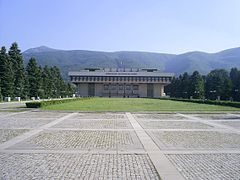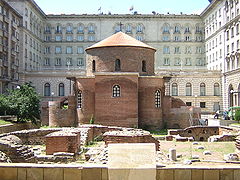![]() Click here to see the map of the area in full screen.
Click here to see the map of the area in full screen.

THE Sophia (Bulgarian: София) is its capital and largest city Of Bulgaria. Located in WestBulgaria, on the slopes of Mount Vitosa.
At a glance
Sofia is the 14th largest city in European Union with a population of over 1.3 million inhabitants. It is located in the center Balkan Hersonissos, in the middle between the Black Sea and the Adriatic Sea, while the closest to this sea is the Aegean. It is less than 50 km. by road from Serbian borders.
Sofia has been a place of human habitation since at least 7,000 BC. and the second oldest city in Europe, founded 7,000 years ago, while the slogan of the city is "grows but does not grow old". The earliest official reference to the city was in the 7th century BC Many of Bulgaria's largest universities, cultural institutions and commercial enterprises are concentrated in Sofia. Sofia was the most affordable European capital to visit in 2013.
Some of the largest telecommunications companies, television and radio stations, newspapers, magazines and portals are based in Sofia, such as the Bulgarian National Television, bTV and Nova TV (private). The newspapers with the highest circulation are 24 Hours and Trud.
Ideal period of visit
Sofia has a humid continental climate (Climate classification Keppen) with an average annual temperature of 10.6 ° C.
Winters are cold and snowy. On colder days temperatures can drop below −15 ° C, especially in January. The lowest temperature recorded is −28.3 ° C (January 24, 1942). Fogs are common, especially in early winter. On average, Sofia receives a total snowfall of 99 cm and 60 days of snow cover. The recorded winter with the most snow was 1939/1940 with a total snowfall of 198 cm. The snow thickness record is 57 cm (December 25, 2001).
Summers are hot and sunny. In summer the city generally remains slightly cooler than other parts of Bulgaria, due to its higher altitude. However the city receives heat waves with high temperatures reaching or exceeding 35 ° C on the hottest days, especially in July and August. The highest recorded temperature is 41 ° C (5 July 2000 and 24 July 2007). The warmest recorded summer was 2012, with an average daily temperature of July 24.8 ° C.
Spring and autumn in Sofia are relatively short with unstable and intense weather.
The city receives an average waterfall of 581.8 mm per year, peaking at the end of spring and the beginning of summer, when thunderstorms are frequent. The wettest recorded year was 2014 with a total waterfall of 1,066.6 mm.
How to get there
Sofia is one of the most visited destinations in Bulgaria, along with beach and mountain resorts. The city is its main railway junction Of Bulgaria and has 8 train stations. Sofia Airport is the largest in the country.
 By air
By air
 By train
By train
 By road
By road
 By boat
By boat
Orient yourself
Vitosa Avenue, otherwise known as Vitoska, is pedestrianized with many cafes, restaurants, fashion boutiques and luxury shops.
How to move
In Sofia you can move around by renting a car. AVIS,Imperial Car Rental Sofia, Hertz
What to see


Sofia has the largest museum collections in Bulgaria, which attract tourists and students for practical studies.
- Alexander Nevsky Cathedral. The crypt of Alexander Nevsky Cathedral contains a collection of Eastern Orthodox icons from the 9th to the 19th century.
- Church of Bojana, Boyansko Ezero 1-3 (In the homonymous suburb at the foot of Mount Vitosa. From the center by trams 9 or 10 to the finish line and then by bus # 64.). - The Church of Bojana is included in the list of UNESCO World Heritage Sites since 1979. The frescoes inside the church, which date from 1259, are one of the most important examples of Bulgarian medieval painting.
- National History Museum (National Historical Museum), 16 Vitoshko lale (ul. Vitoshko lale 16) (Trolley # 2), ☎ 359 2 955 42 80, fax: 359 2 955 76 02, e-mail: [email protected]. 09:30-18:00. - The National History Museum in the Bojana area has a huge collection of over 600,000 historical artifacts, dating from prehistoric to modern times, although only 10,000 of them are permanently on display due to lack of space. 10 leva.
- National Museum "Earth and Man" (National Museum "Earth and People"), Cherni Vruh 4, ☎ 359 2 865 66 39, fax: 359 2 866 14 57, e-mail: [email protected]. 10 AM-6PM. - The museum has minerals, animal species and rare earths 2 leva.
- National Museum of Military History, 92 Cherkovna Str., ☎ 359 2 946 18 05, fax: 359 2 946 18 06, e-mail: [email protected]. 10.00 to 18.00. - Large collections of weapons
- National Archaeological Museum, Saborna 2 (The museum is housed in a former mosque located between the buildings of the National Bank and the Presidency). - The former mosque of Sofia today houses collections of objects more relevant to the history of the city.
- National Gallery, 1 Batenberg Sq., ☎ 359 2 980 00 93. 10:30 to 18:00. - The National Gallery houses a collection of works mainly by Bulgarian artists 4 leva.
- National Gallery of Foreign Art, . Alexander Nevsky 1, ☎ 359 2 988 49 22, e-mail: [email protected]. 11:00 to 18:00. - The National Gallery of Foreign Art exhibits exclusively foreign works, mainly from India, Africa, China and Europe. Her collections include a variety of cultural works, including sculptures from the Asadi Empire (Ghana), Buddhist art, Dutch Golden Age (17th) paintings, works by Albrecht Dürer, Jean-Baptiste Grez and Auguste Rodin. 4 leva.
Other museums are the National Polytechnic Museum, with over 1000 objects of technology on display and the Museum of Natural History. The Ethnographic Museum is another point of interest, with large collections of Bulgarian folk costumes. The National Library of Saints Cyril and Methodius houses the largest national collection of books and documents (1,714,211 books and about 6 million other documents) and is the oldest cultural institution in Bulgaria.
Rotunda of Agios Georgios

Basilica of Hagia Sophia
Church of Bojana

National History Museum

National Archaeological Museum
National Museum "Earth and Man"

National Gallery of Foreign Art
Entertainment
Sofia gathers the majority of its artistic troupes Of Bulgaria. The theater is by far the most popular form of performing art and the theatrical venues receive the most visitors after the cinemas. The oldest such institution is the Ivan Vazov National Theater, where many classical works are staged and located right in the center of the city. Many smaller theaters, such as the Sfumata Theatrical Workshop, feature both classical and contemporary works.
The National Opera and Ballet was founded in 1891. However, it began performing on a permanent basis in 1909. Some of Bulgaria's most famous opera singers, such as Nikolai Gyurov and Gena Dimitrova, made their first appearances there. The Bulgarian Hall and Room 1 of the National Palace of Culture regularly host classical music concerts, given by both foreign orchestras and the Sofia Philharmonic. The city has hosted many world-renowned musicians, including AC / DC, Sting, Elton John, Madonna, George Michael, Metallica, Tiësto, Kylie Minogue, Depeche Mode, Rammstein, Rihanna, Roxett and Lady Gaga.
Cinema is the most popular form of entertainment. In recent years, movie theaters have been concentrated in shopping malls and independent theaters have closed. The Mall of Sofia has one of the largest IMAX cinemas in Europe. Most of the films are American productions, although more and more European and domestic films are being screened. Odeon (not part of the movie chain of the same name) screens exclusively European and independent American films, as well as classics of the 20th century. Bulgaria's once-thriving film industry, concentrated in Bojana Film Studios, experienced a period of decline after 1990. Its relative recovery began after 2001. Since the acquisition of Bojana Film by the American Nu Image, many relatively successful productions have been filmed in and around Sofia, such as The Contract (2006), The Black Dahlia (2006 - Josh Hartnett, Scarlett Johansson, Hillary Swank), Hitman (2007), Conan the Barbarian (2011 - Rose McGowan). Nu Bojana Film Studios have also hosted some of the scenes in Consumables 2.
Studies

Sofia University was founded in 1888 and is the oldest in Bulgaria. There are 16 faculties at the university.
The city is home to many cultural institutions, such as the Russian, Polish, Hungarian, Czech and Slovak, Italian, French, Goethe-Institut, the British Council, the Cervantes Institute, and the Open Society Institute. temporary exhibitions of visual, audio and literary works by artists from the respective countries.








